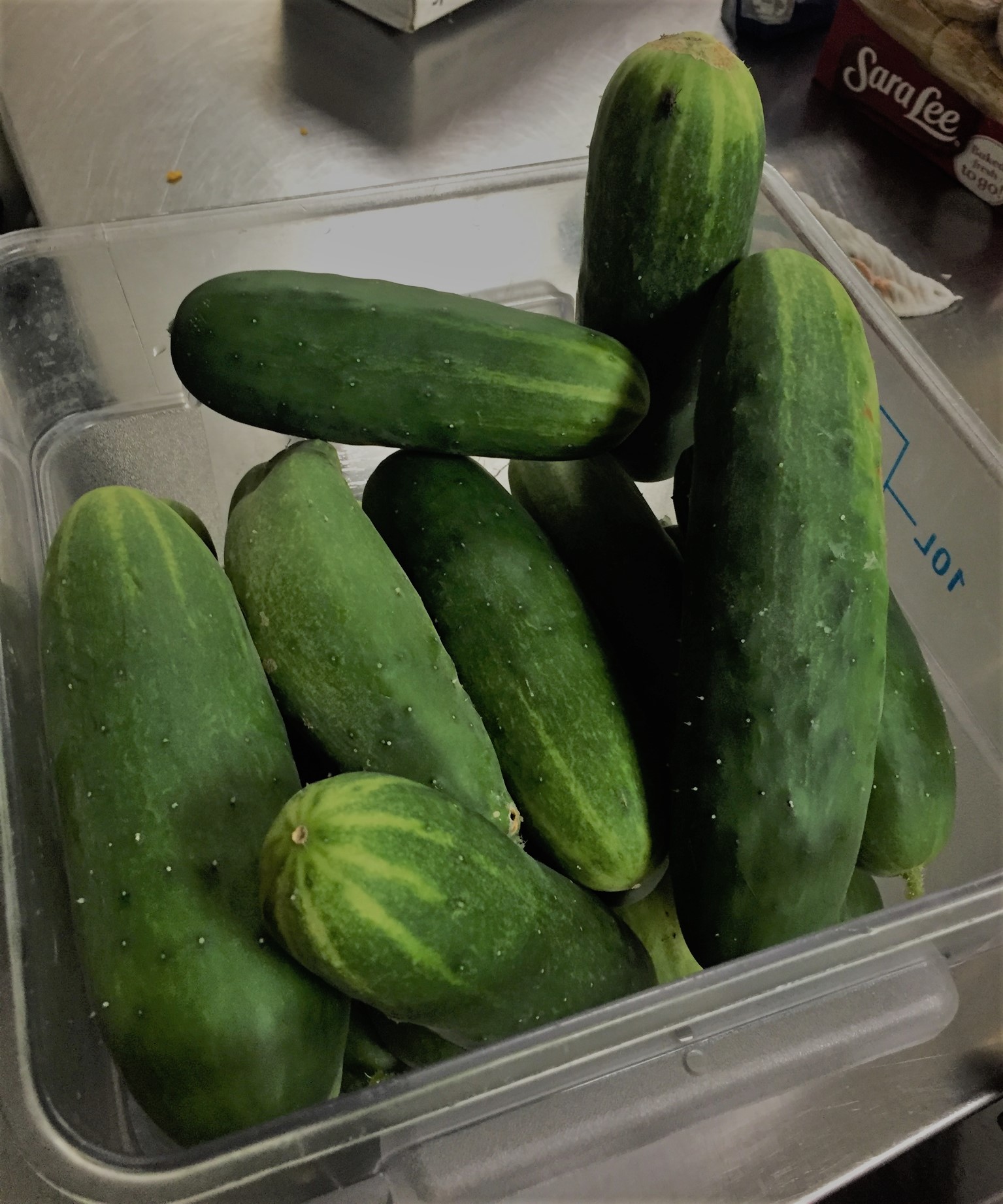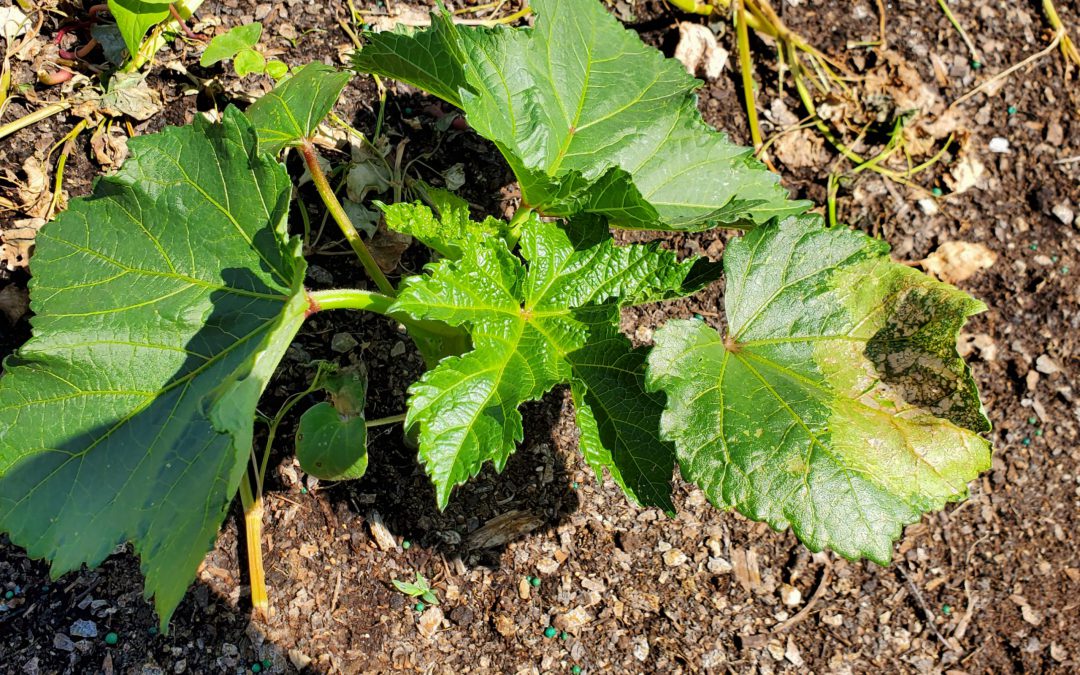
by Daniel J. Leonard | May 13, 2020
It’s been a challenging spring in this guy’s garden! Despite getting the normal early start required for successful gardening in Florida, I’ve been affected by Bacterial Leaf Spot stunting my tomatoes, cutworms that reduced my watermelon plantings by half, and an eternal test of my patience in the form of a dog that seems to think my raised beds are merely a shortcut to a destination further out in the yard. My latest adversary is the most potentially destructive yet, an outbreak of Southern Armyworm (Spodoptera eridania).
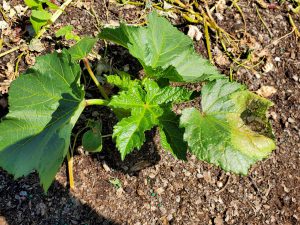
Early Southern Armyworm damage on Okra seedlings. Photo courtesy of the author.
Unlike some serious garden pests that wait until the heat of summer to emerge, Southern Armyworms begin appearing in spring gardens around the end of April. Adult moths can survive mildly cold weather and venture into the Panhandle as soon as warmer spring weather arrives. Once the adult moths arrive, egg masses are then laid on the undersides of leaves and hatch in a little under a week. Once loosed upon the world, Southern Armyworm larvae (caterpillars) become indiscriminate, voracious feeders and congregate in extremely large numbers, allowing them to destroy small, developing garden vegetable plants in a manner of days. Young larvae feed on the undersides of leaves and leave little but a skeleton. As larvae grow larger, they become solitary and begin to bore into fruit. Once they’ve eaten the good stuff (leaves and fruit), large larvae turn to branches and even plant stems!
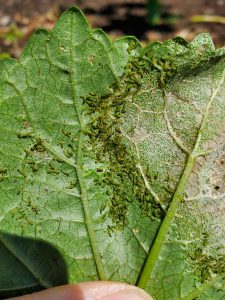
Southern Armyworm larvae feeding on Okra leaves. Photo courtesy of the author.
The good news for gardeners is that Southern Armyworm, and most other caterpillar pests, are easily controlled if outbreaks are caught early. Scouting is critical for early detection and good control. Armyworm damage generally appears from above as brownish-gray sections of affected leaves with a yellowish ring surrounding these sections, this ring indicates the current feeding zone. Affected areas will appear transparent and “lacy” due to the skeletonizing effects of larval feeding. If you see leaves that look “off” in the manner just described, check underneath for the presence of a horde of tiny greenish worms.
If found in this early stage, an application of Bacillus thuringiensis (Bt), a biological pesticide utilizing a bacterium destructive to caterpillars, is extremely effective. Bt has to be ingested by caterpillars with leaf tissue to work; thorough coverage of leaf surfaces is critical for maximum control. I generally follow up with a sequential application of Bt a day later to ensure that I achieved good coverage of the plant surfaces and, therefore, good control. Unfortunately, Bt is much less effective on older larvae. Infestations not caught early require harsher chemistries like carbamates, pyrethroids and organophosphates for adequate control.
Don’t let armyworms or other caterpillar pests destroy your garden, get out there daily and scout! You have a short window for easy caterpillar control with a harmless to people, natural product, Bt. Don’t waste it!
For more information about Southern Armyworm, other caterpillar pests, Bt, or any other horticultural topic, please consult your local UF/IFAS Extension Agent. Happy Gardening!
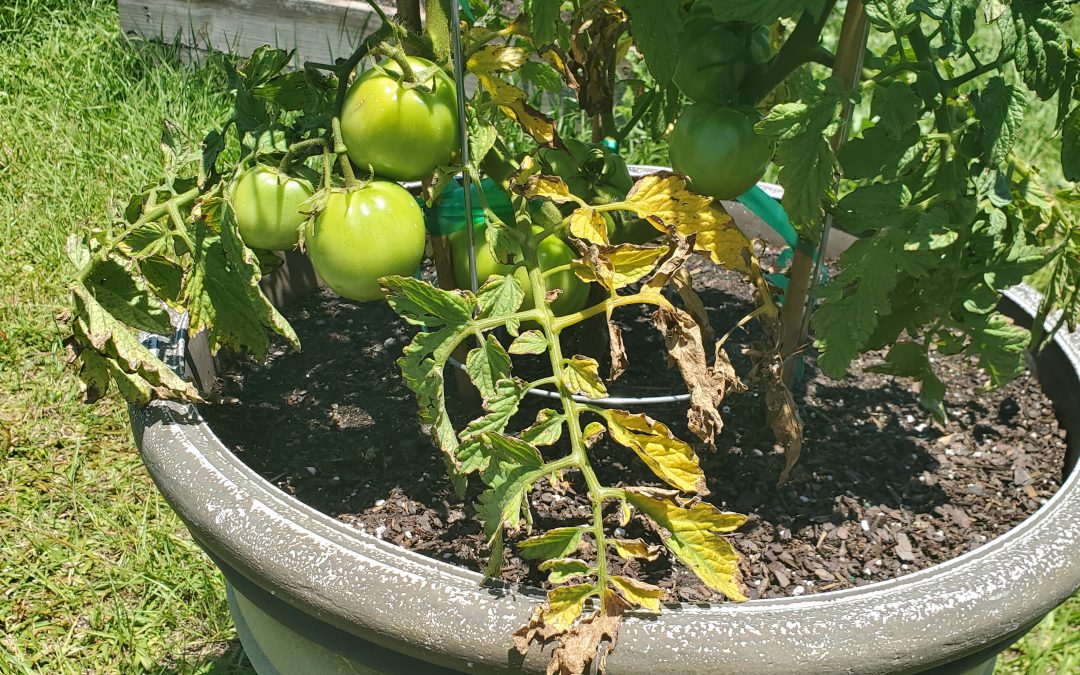
by Daniel J. Leonard | May 7, 2020
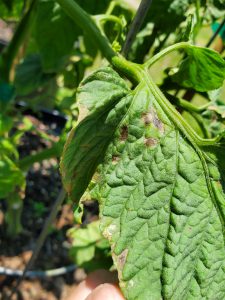
Early BLS symptoms appear on lower leaves. Photo courtesy of the author.
Tomatoes are among the most notoriously difficult vegetable species to grow in Florida. Even when you do everything right (choose disease resistant varieties, buy clean seed/healthy transplants, plant early, rotate crops, scout for insects, prune and support vines, etc), things can go wrong in a hurry. Bacterial Leaf Spot (BLS) caused by the pathogen Xanthomomas perforans, is one of those things. BLS often hitches a ride into gardens undetected on seed and transplants and presents itself as warm and humid weather arrives in late April/early May. Outbreaks typically happen in concurrence with the frequent heavy rainstorms that accompany these months and quickly wreak havoc on tomato plants.
BLS occurrence, much worse in some springs than others, has exploded this year in home gardens. First noticed on the plant’s lower leaves, BLS pathogens enter through natural openings in leaves called stomata, manifest as small, “water-soaked” leaf lesions and then develop within days into dark circular spots, sometimes surrounded by a yellow halo. As conditions worsen, all these individual infections cause a general yellowing or “blighting” of entire leaves. Though the issue begins on tomato leaves, BLS can affect all parts of the plant, including stems, flowers and fruit too! It’s at this point, when blighted leaves become obvious and lesion developing on flower stalks cause both flowers and small fruit to drop, that most home gardeners notice that something is up.
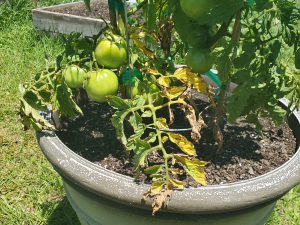
Advancing progression of BLS with “blighted” leaves. Photo courtesy of the author.
Unlike with many other pathogens, gardeners don’t have an abundance of options to control BLS. However, taking the following preventative measures can reduce the pathogen’s impact and stave off disease progression until ripe fruit can be harvested.
- Don’t irrigate overhead. Utilize drip/microirrigation or hand water beds and containers at soil level. This prevents the leaves from becoming wet; wet leaves become a perfect host for BLS.
- Never work tomato plants when leaves are wet. No staking, pruning, tying, or anything else until plant tissue is dry. Working wet tomato plants is an excellent way to spread bacteria!
- Sanitize pruning tools often and wash hands after working infected plants.
- Maintain airflow in plants by planting at correct spacing and thinning interior leaves as necessary to facilitate quicker drying of the plant.
- Prune lower leaves to at least 12” from the soil’s surface to prevent disease transmission from soil to leaves through splashing water.
- Remove infected leaves (when plants are dry!) to slow disease progression.
- Rotate crops and destroy infected plants to prevent buildup of BLS organisms in soil.

BLS lesions on tomato flowers. Photo courtesy of the author.
- Preventative measures are best, but if your garden has a history of BLS and local weather forecasts call for warm/wet/humid weather, it is best to spray fungicides proactively to protect your crop. A weekly spray with a tank mixture of copper and mancozeb is effective at keeping BLS at bay. This is the only chemical spray combination proven to be effective in controlling BLS.
- Unlike many common tomato pathogens that can be reliably avoided through planting resistant cultivars like ‘Big Beef’, ‘Celebrity’ and others, no varieties are resistant to BLS.
While BLS is an extremely destructive pathogen of both home and commercially grown tomatoes, growers can lessen the disease’s effects by following the preventative measures outlined above and spraying with a copper/mancozeb mix if necessary. Growing tomatoes this year hasn’t been easy, but it’s worth it to fight back and realize a harvest despite difficulties like BLS!
If bacteria have given you the blues or other garden issues are bringing you down, give your local UF/IFAS County Extension Agent a call! We’re here to help you be successful in all your horticultural endeavors. Happy gardening!
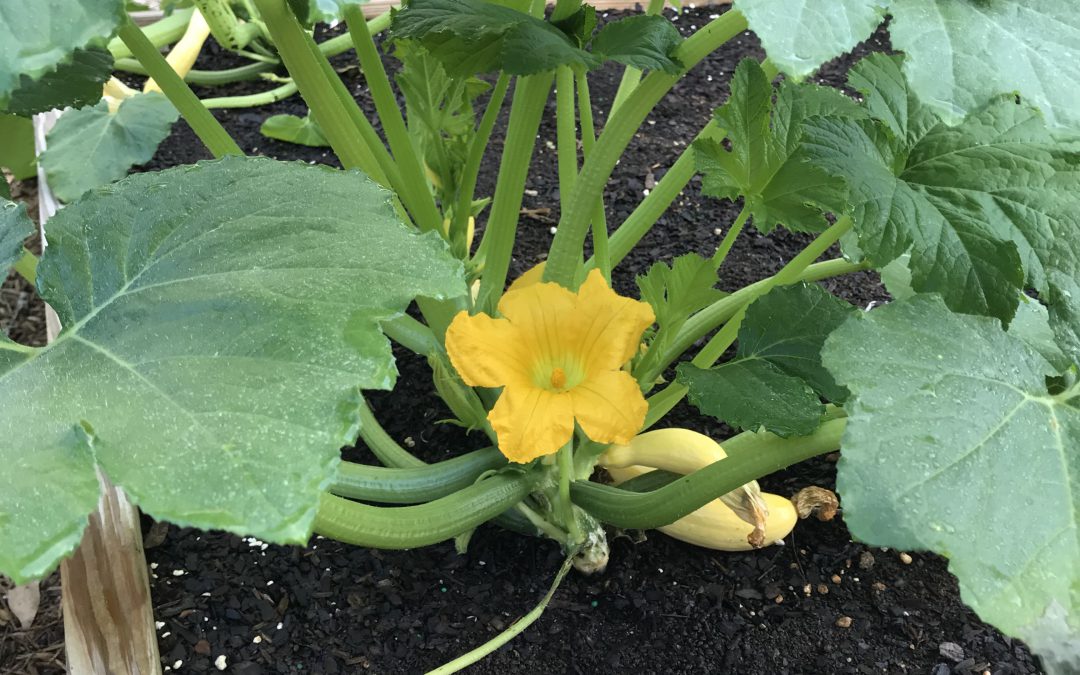
by Daniel J. Leonard | Apr 29, 2020

‘Multipik’ fruit. Photo courtesy the author.
Never one to be satisfied growing “standard” vegetable varieties, last year I decided to peruse various seed sources in search of a superior yellow summer squash selection. Plain ‘Yellow Crookneck’ just wasn’t doing it for me anymore. After doing a little research and consulting a friend who works for Johnny’s Selected Seeds, I settled on a straightneck variety called ‘Multipik’.
Developed in the 1980’s by Harris Seed and now sold by many seed purveyors, ‘Multipik’ enjoyed immediate popularity with commercial squash growers due to its many outstanding qualities but curiously, is just making inroads with the home garden market. Even as it is set to celebrate its 30th anniversary next year, two years of personal experience with ‘Multipik’ verify several important characteristics making it a superior choice to many other traditional summer squash varieties: earliness/heavy yields and a precocious gene.
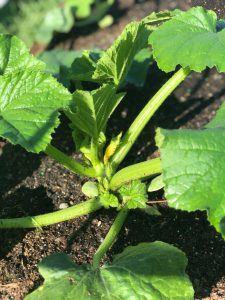
Newly developing ‘Multipik’ fruit. 4 weeks after planting. Photo courtesy the author.
The longer I garden, the more I’m convinced that earliness to maturity is directly related to yield potential in home gardens, especially in the Panhandle. Lots of varieties have high yield potential but that potential is often at least partially wasted here due to the length of time from seed to harvest. Ideally, you could plant, grow a crop and be done by mid-late June, before intense heat, humidity and all the wonderful garden pests and diseases arrive to destroy spring gardens. Maturing just 50 days from planting, ‘Multipik’ beats that deadline (when planted on time in late March) and yields heavily for at least a month before succumbing to the harsh Panhandle summer. Many traditional summer squash varieties, including ‘Yellow Crookneck’ mature 8-14 days later. While 8-14 days doesn’t sound like much, it can mean a major yield difference when factoring in the almost certain late season pests, diseases, and adverse weather conditions.
The next major advantage ‘Multipik’ offers is a precocious gene, meaning that it will mask symptoms and maintain its yellow color if infected with either Watermelon Mosaic Virus (WMV) or Cucumber Mosaic Virus (CMV), two destructive pathogens commonly affecting squash by discoloring fruit and reducing yield. This trait is critical to commercial growers because yellow squash that isn’t yellow isn’t marketable and is important to home gardeners too as a means to eke out higher yields under virus pressure. While the precocious gene isn’t a cure for either virus, it can help hold them at bay while you harvest! Another quirk caused by the precocious gene is the all-yellow appearance of the fruit, from the peduncle (the stalk holding the fruit to the plant) to the apex! From one end of the fruit to the other, Multipik ensures that when you plant yellow squash, you harvest yellow squash.
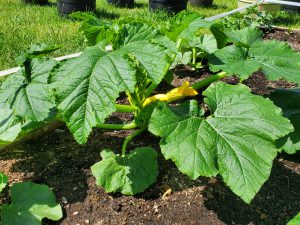
‘Multipik’ just days from harvest. Photo courtesy the author.
Whether you are trying to avoid yield loss from late season insect and disease pressure plaguing your traditional squash plantings or just want to try something a little different, I highly recommend planting ‘Multipik’ Squash. This early, disease-resistant cultivar with delicious medium sized, light yellow fruit is sure to be a hit in both in the garden and on the table. As always, if you have any questions about vegetable gardening or any other horticultural topic, give your local UF/IFAS County Extension Office a call! Happy gardening!
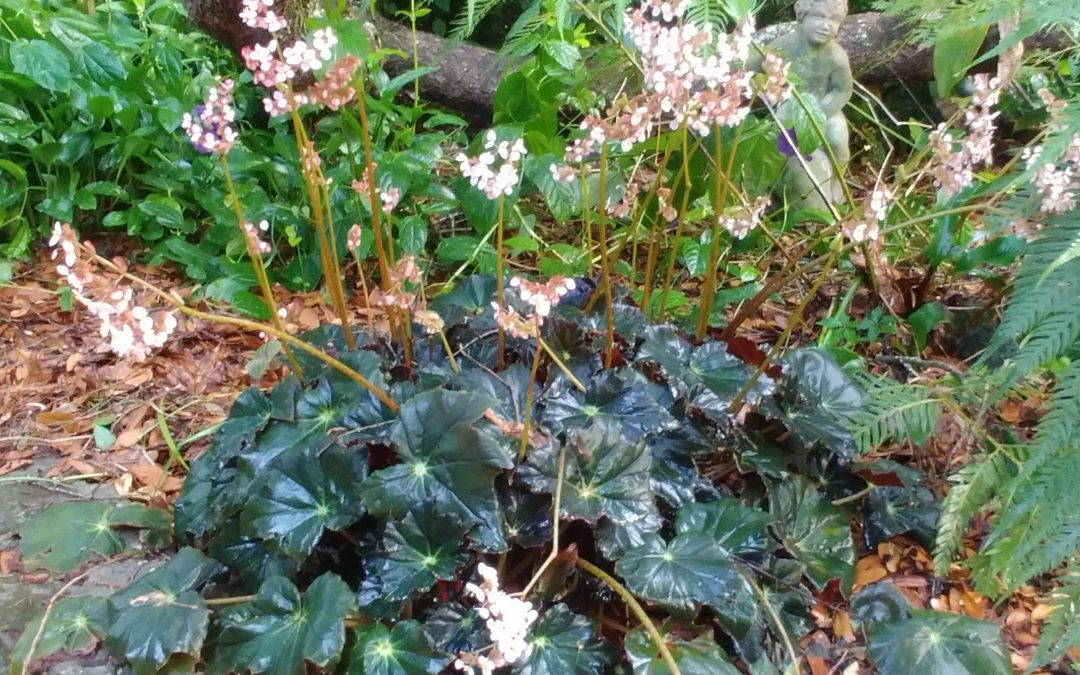
by Gary Knox | Apr 23, 2020
Article by Dr. Gary Knox, Professor of Environmental Horticulture at the UF/IFAS NFREC Quincy
Introduction
Rhizomatous begonias are a large group of Begonia species, hybrids and selections characterized by large, sometimes-colorful leaves arising from thick rhizomes that grow along the soil surface. White or pink flower clusters that appear in late winter and spring are an extra bonus with these plants. Some types can be used in north Florida as herbaceous perennials that add bold leaf texture and color as well as flowers to shady gardens.
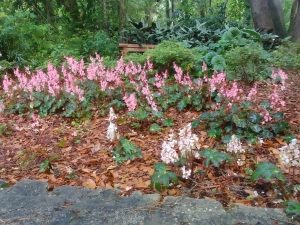
Begonia mass planting
Common rhizomatous begonias such as Begonia nelumbiifolia, ‘Erythrophylla’ (“Beefsteak”), and ‘Ricinifolia’ have long been grown outdoors in south and central Florida gardens as herbaceous perennials. North of these areas, rhizomatous begonias were considered cold sensitive and thus used strictly as pot-grown plants grown indoors or protected over winter. Nonetheless, north Florida trials testing the performance of outdoor, in-ground plantings started in Tallahassee and Gainesville as long ago as the late 1980s and early 1990s. With the proven success of some rhizomatous begonias in north Florida, interest in these plants increased rapidly in the early 2000s. Since then, savvy north Florida gardeners have been delighted by the possibility of using rhizomatous begonias as interesting herbaceous perennials for the shade garden. While temperatures below freezing can damage or kill leaves, these plants will usually produce new leaves from the rhizomes once warmer temperatures return in spring.
Plant Description Under North Florida Conditions
Leaves of rhizomatous begonias are this plant’s most distinctive feature and are why this group is so appealing to gardeners. Leaves often are large, from a few inches wide to almost 3 ft. in diameter (as reported for the cultivar ‘Freddie’ under the right conditions). Leaf shape may be rounded, star-shaped or irregularly edged, and leaf colors include burgundy, red, bronze, chartreuse, silver, and various shades of green including one so dark as to be almost black. Many types have leaves displaying patterns of one or more colors and some have silver or red markings. Undersides of leaves are often burgundy-colored, and leaf stems (petioles) also may exhibit colors other than or in addition to green. Leaves may be smooth, textured, or fuzzy-appearing due to large numbers of sometimes conspicuous hairs. Some types have leaves with an interesting three-dimensional spiral located on top of the leaf where the leaf blade attaches to the stem.
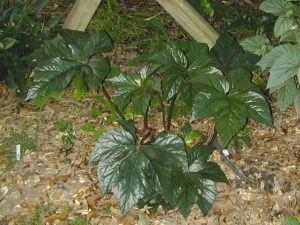
Begonia ‘Big Mac’ foliage
Rhizomatous begonia rhizomes are thickened, fleshy stems 1 to 2 in. or more in diameter that grow, branch and spread horizontally at or just below the soil surface, often in the mulch or leaf duff. Adventitious roots develop along the rhizome, and dormant buds embedded in the horizontal stem can be stimulated to grow new leaves after damage, stress or when divided. With age, as rhizomes grow outward, the oldest part of the rhizome will stop producing leaves and eventually die.
The rhizomes contain water and food reserves that allow this type of begonia to survive environmental stresses like drought as well as leaf loss or damage from cold temperatures. Shoots and roots can grow from the rhizome even if leaves and roots are killed or damaged.
Flowers occur in late winter to spring, depending on the species, cultivar and weather, and are quite showy on some selections. Flowers typically are white to various shades of pink and occur in a cluster (technically called a cyme) held above the foliage, in some cases dramatically high above the foliage. Individual flowers may range in size from 3/8-inch to over 2 inches at their widest point and a flower cluster may contain a few to over 120 individual flowers, depending on selection and growing conditions. A mature rhizomatous begonia may have an extended period of flowering, providing weeks of color. This long floral display results from large numbers of flowers developing sequentially on an individual flower cluster such that new flowers are still forming long after the first flowers have opened. Furthermore, multiple flower clusters appear over an extended time period. Flowers occasionally are pollinated and form winged seed capsules, though seed production and viability are variable. After flowering, the leaves remain a point of interest in the garden due to their size, lush appearance, interesting shapes and colorful patterns.
Cultural Requirements, Use and Maintenance
Rhizomatous begonias grow best in light shade or indirect light but can tolerate morning sun. Plants thrive in rich, organic, well-drained soil that is moist but not wet. A layer of organic mulch or leaf litter often is enough to provide basic conditions for growth in most soils if they are well-drained. Accordingly, organic mulches or leaf litter should be applied regularly around plants. Fertilizer stimulates growth but decomposing organic mulches can provide adequate nutrients, except perhaps with poor or sandy soils.
Newly planted begonias should be watered regularly. After establishment, most rhizomatous begonias benefit from regular watering but only require irrigation during periods of drought or extended dry weather.
An individual plant makes an attractive specimen plant in a container or in the garden. With time, a rhizomatous begonia can spread and, in the garden, develop into a patch. Alternatively, planting large numbers of the same rhizomatous begonia can create a very dramatic garden border, mass planting, or groundcover, especially in spring when all plants are flowering. To achieve this effect more rapidly and with smaller numbers of plants, tips of rhizomes can be pruned to stimulate rhizome branching and result in a denser plant or patch. Rhizome tip pruning should be done after plants finish flowering. Plants can be divided and moved easily since only the rhizome is needed to establish a new plant, but this should occur after flowering and early in the growing season so plants have long enough to establish before cold weather.
For aesthetic purposes, dead or damaged leaves may be removed as needed but especially after frosts and hard freezes. Similarly, leaves that overwinter often become “ratty” in appearance with time and may be removed without affecting plant growth.
Potential Problems
Rhizomatous begonias have few pests or other problems. Mealy bugs can occasionally infest plants. As with other large-leaved plants, wind or physical contact can tear and damage leaves. In north Florida, winter frosts and freezes can damage and disfigure leaves or kill leaves entirely, causing them to lose structural integrity and collapse, appearing mushy. Foliage may be protected during cold weather by frost cloth, sheets or other typical cold protection strategies, though heavy coverings could themselves damage leaves.
Rhizomes themselves usually survive cold weather because they are insulated from low temperatures by being half-buried in the ground and/or being covered by mulch. Adding mulch regularly to rhizomatous begonia plants will provide increased freeze-protection. Also, their typical planting location under tree canopies protects plants from a radiation freeze. Soil drainage is a more important factor for rhizomes since wet soil conditions could lead to rot, particularly in winter.
Common Types and their Descriptions Under North Florida Conditions
With hundreds of species and thousands of cultivars and hybrids, rhizomatous begonias can be overwhelming. Many rhizomatous begonias look alike and even experts have difficulty distinguishing species and cultivars. Many grown in north Florida have their origins in Mexico, Central and South America, though the Begonia Family is huge and species are found nearly world-wide.
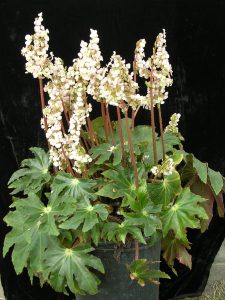
Begonia heracleifolia
Technically rhizomatous begonias include Rex begonias, a group derived from Asian native, Begonia rex, and known for their especially colorful leaves. However, most Rex begonias do not grow well in Florida’s heat, high rainfall and high humidity, and so these begonias are excluded here.
Begonias listed below represent types that have proven resilient and usually cold hardy in north Florida USDA Cold Hardiness Zone 8b.
Species:
Begonia heracleifolia: The species boasts star-shaped leaves up to 6 in. across on stiff, hairy, thick leaf stems (petioles) up to 5 in. long. Each of the pointed leaf lobes is edged in dark green and has a chartreuse stripe along the central midrib, adding contrast. Spectacular sprays of pale pink flowers appear in late winter in clusters measuring 3 ½ in. by 4 ½ in. on 6-in. flower stalks (pedicels). Each cluster contains about 30 or more flowers, each about 1 in. across. As the season goes on, foliage gets showier and showier. It often dies down after winter freezes but re-emerges in late spring.
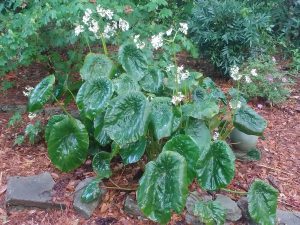
Begonia nelumbiifolia
- nelumbiifolia: This cold hardy begonia is known for its exceptionally large, water lotus-shaped leaves, creating a stunning specimen. Individual leaves can grow as large as 18 in. by 14 in. on leaf stems as long as 36 in. but 12 in. by 9 in. leaves are more typical. As temperatures warm, new developing foliage continues to get bigger, growing into very large leaves by fall. There also is a form in which the medium green leaves have red veining. White flowers are displayed above the foliage in mid to late spring in airy clusters measuring 7 ½ in. to more than 12 in. across on stems up to 48 in. tall. Clusters may contain as many as an astounding 120 flowers, each about ¾ in. across at its widest point.
2. popenoei: Huge rounded leaves with red veins and undersides make this a specimen plant which can grow to 3 ½ ft. tall and wide. Hardy with protection, it throws up tall stalks with clusters of white flowers in late winter.
Cultivars:
“Beefsteak”: This catch-all name refers to the original beefsteak begonia, ‘Erythrophylla’, as well as many derivatives that look similar. Beefsteak begonias characteristically have rounded leaves with a glossy green to bronze top surface and reddish undersides. Leaves range in size from 4 to 7 in. in diameter, and flower clusters are on stems up to 18 in. tall. ‘Erythrophylla’ was developed in 1847 and is considered a tough, vigorous plant, hence the common name, “beefsteak”. Given the long history and vigor, ‘Erythrophylla’ and derivative beefsteak begonias have long been shared as pass-along plants, world-wide as potted plants and later as an in-ground Florida garden plant. One type has ruddy, evergreen leaves and long-lasting, bold pink flower clusters. The scalloped 4-in leaves are on short 5 ½ in. reddish leaf stems but are most notable for remaining undamaged by temperatures down to the mid 20s °F, long after all other begonias’ leaves have turned to mush. Mid spring finds this plant topped by numerous clusters of dark pink flowers, with the display lasting 6 weeks or more. Individual clusters are about 8 in. by 5 in. on flower stems about 12 in. tall. Each cluster contains about 20 flowers each about ¾ in. wide at its widest point.
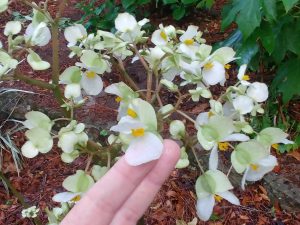
Begonia ‘Big Mac’ in flower
‘Big Mac’: This is a large, vigorous plant with enormous star-shaped leaves having reddish undertones and red leaf stems. The plant grows about 3 ft. tall and 2 ft. wide. Individual leaves may grow up to 18 in. wide on 16-in. leaf stems but typical leaves on younger plants are 10 in. to 12 in. wide. Individual white flowers are an amazing 2 in. wide at their widest point in clusters measuring 7 in. by 12 in. and containing about 75 flowers. Cold winters will knock it to the ground, but this begonia re-emerges again in late spring. This plant was hybridized in 1982 by Paul P. Lowe in Lake Park, Florida.
‘Joe Hayden’: This begonia features dramatic, dark, lobed leaves with burgundy undersides. Leaves are up to 8 in. long supported by leaf stems up to 9 in. long. In spring, the plant is topped by light pink flowers held high above the foliage. Each cluster measures about 5 in. by 7 in. on flower stems up to 26 in. tall. Each cluster contains more than 100 individual flowers, each about ¾ in. across at its widest point. This selection was hybridized in California in 1953 by Rudolf Ziesenhenne, but many similar selections have been made and are often confused with ‘Joe Hayden’.
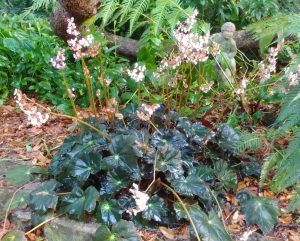
Begonia ‘Joe Hayden’
Many other cultivars are common, but other cold hardy types suitable for north Florida include ‘Caribbean King’, ‘Caribbean Queen’, ‘Washington State’ and the catch-all ‘Ricinifolia’ types (with large, castor bean-shaped leaves). New breeding by scientists and enthusiasts promises to deliver many more types of rhizomatous begonias with increased foliage cold hardiness and an expanded range of foliage types and colors. A major Texas nursery introduced a series of rhizomatous begonia hybrids marketed as Crown Jewel Begonia™. The series currently features five patent-pending cultivars that are promoted as landscape plants for Zone 8. Additional breeding work is ongoing in north Florida.
Availability and Propagation
Rhizomatous begonias are available from Internet/mail order nurseries, some American Begonia Society members, other gardening groups, and plant societies. The introduction of trademarked rhizomatous begonias like Crown Jewel Begonia™ show promise for wider availability of rhizomatous begonias from nurseries.
Rhizomatous begonias are easily propagated by division, separation of rhizomes, or by rhizome pieces. When planting, place the rhizome or pieces (as small as 2 in. long) horizontally and half buried in a new in-ground location or in a container with potting soil. As with other begonia species, leaves may be used for propagation, though this method usually takes longer to achieve a size suitable for planting in the garden. Plants can be grown from seeds but production time is similarly long.
References:
American Begonia Society. (2020) https://www.begonias.org/index.htm. Accessed 15 April 2020.
Ginori, Julian, Heqiang Huo, and Caroline R. Warwick. (2020) A Beginner’s Guide to Begonias: Classification and Diversity, ENH1317. Environmental Horticulture Department, UF/IFAS Extension. January 2020. https://edis.ifas.ufl.edu/ep581.
Lowe, Paul. (1991) Growing Rhizomatous Begonias in the Ground in Southern Florida. Begonian 58:89. May/June 1991. https://www.begonias.org/Articles/Vol58/GrowingRhizomatousBegoniasFlorida.htm.
Schoellhorn, R. (2020) Personal communication, Alachua, FL.
Sharp, Peter G. (2011) Down to Earth – with begonias. 111 pp. http://ibegonias.filemakerstudio.com.au/PeterSharp/DownToEarthWithBegonias.pdf.
The International Database of the BEGONIACEAE. (2020) http://ibegonias.filemakerstudio.com.au/index.php?-link=Home. Accessed 16 April 2020.
UF/IFAS Gardening Solutions. (2019) Begonias. http://gardeningsolutions.ifas.ufl.edu/plants/ornamentals/begonias.html.
Watkins, Sue. (2020) Personal communication, Tallahassee, FL.












